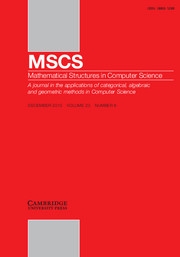Crossref Citations
This article has been cited by the following publications. This list is generated based on data provided by
Crossref.
Corradini, Andrea
2002.
GETGRATS.
Electronic Notes in Theoretical Computer Science,
Vol. 51,
Issue. ,
p.
1.
Drewes, Frank
Hoffmann, Berthold
and
Plump, Detlef
2002.
Hierarchical Graph Transformation.
Journal of Computer and System Sciences,
Vol. 64,
Issue. 2,
p.
249.
Habel, Annegret
and
Plump, Detlef
2002.
Graph Transformation.
Vol. 2505,
Issue. ,
p.
135.
Ehrig, Hartmut
Habel, Annegret
and
Parisi-Presicce, F.
2002.
Basic Results for Two Types of High-Level Replacement Systems
.
Electronic Notes in Theoretical Computer Science,
Vol. 51,
Issue. ,
p.
127.
Bakewell, Adam
Plump, Detlef
and
Runciman, Colin
2004.
Relational and Kleene-Algebraic Methods in Computer Science.
Vol. 3051,
Issue. ,
p.
48.
Corradini, Andrea
Dotti, Fernando Luís
Foss, Luciana
and
Ribeiro, Leila
2004.
Graph Transformations.
Vol. 3256,
Issue. ,
p.
383.
Habel, Annegret
and
Hoffmann, Berthold
2004.
Graph Transformations.
Vol. 3256,
Issue. ,
p.
178.
Plump, Detlef
and
Steinert, Sandra
2004.
Graph Transformations.
Vol. 3256,
Issue. ,
p.
128.
Habel, Annegret
and
Pennemann, Karl-Heinz
2005.
Formal Methods in Software and Systems Modeling.
Vol. 3393,
Issue. ,
p.
293.
Corradini, Andrea
and
Gadducci, Fabio
2005.
On Term Graphs as an Adhesive Category.
Electronic Notes in Theoretical Computer Science,
Vol. 127,
Issue. 5,
p.
43.
Hoffmann, Berthold
2005.
Formal Methods in Software and Systems Modeling.
Vol. 3393,
Issue. ,
p.
101.
Reussner, Ralf H.
Happe, Jens
and
Habel, Annegret
2005.
Fundamental Approaches to Software Engineering.
Vol. 3442,
Issue. ,
p.
80.
Gadducci, Fabio
and
Montanari, Ugo
2005.
Formal Methods in Software and Systems Modeling.
Vol. 3393,
Issue. ,
p.
84.
Plump, Detlef
2005.
Processes, Terms and Cycles: Steps on the Road to Infinity.
Vol. 3838,
Issue. ,
p.
280.
Baldan, Paolo
Gadducci, Fabio
and
Montanari, Ugo
2006.
CONCUR 2006 – Concurrency Theory.
Vol. 4137,
Issue. ,
p.
279.
Habel, Annegret
and
Pennemann, Karl-Heinz
2006.
Graph Transformations.
Vol. 4178,
Issue. ,
p.
430.
Baldan, Paolo
Corradini, Andrea
Foss, Luciana
and
Gadducci, Fabio
2006.
Graph Transformations.
Vol. 4178,
Issue. ,
p.
199.
Corradini, Andrea
Heindel, Tobias
Hermann, Frank
and
König, Barbara
2006.
Graph Transformations.
Vol. 4178,
Issue. ,
p.
30.
Baldan, Paolo
Corradini, Andrea
Heindel, Tobias
König, Barbara
and
Sobociński, Paweł
2006.
Foundations of Software Science and Computation Structures.
Vol. 3921,
Issue. ,
p.
202.
Bonchi, Filippo
and
Heindel, Tobias
2007.
Adhesive DPO Parallelism for Monic Matches.
Electronic Notes in Theoretical Computer Science,
Vol. 175,
Issue. 4,
p.
51.

